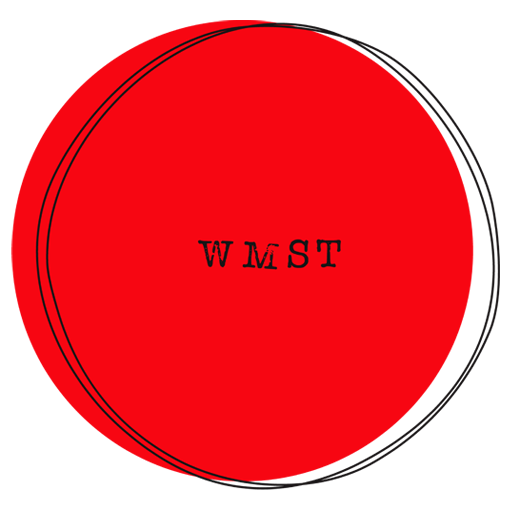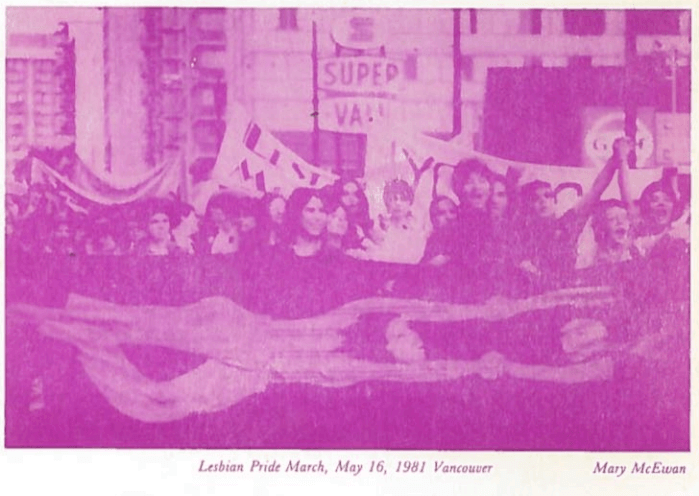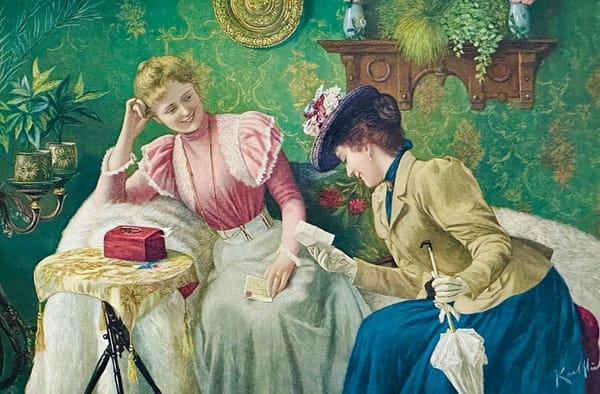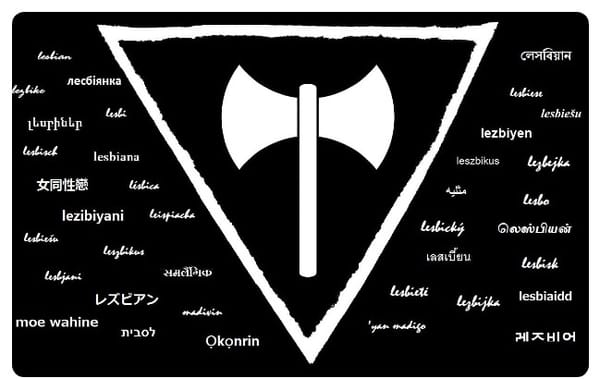Sapphic Circle is a space for lesbians to come together for thoughtful discussions on a variety of topics. We seek to build lesbian community through engaging in lesbian ideas, politics, media, and more!
Before The Dyke March
Before the idea of formal Dyke Marches came into existence, lesbians already had, and followed through on, the impulse to be visible on our own terms. On May 16th, 1981, a significant number of lesbians were in Vancouver to attend the Bi-Annual Lesbian Conference. About 200 lesbians started an impromptu march, infamously chanting, "Look over here, look over there, lesbians are everywhere!"
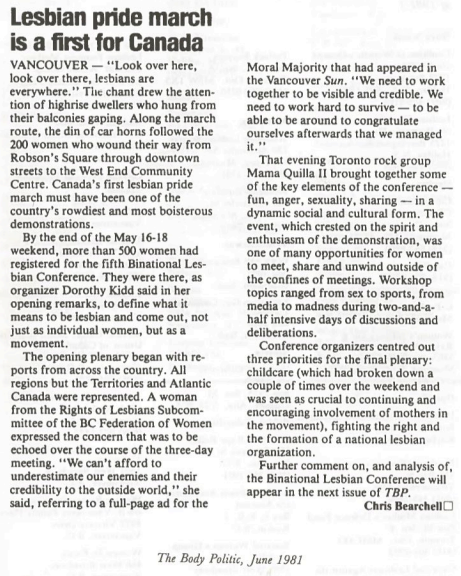
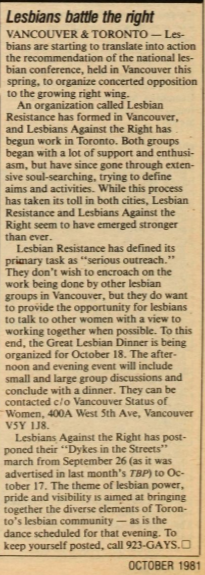
A few months later, in October 1981, a similar march took place in Toronto, but this one was more intentionally organized by the Lesbians Against the Right (LAR). This march was called "Dykes in the Streets" and had an attendance of about 350. Originally the members of LAR were simply part of Gays and Lesbians Against the Right Everywhere (GLARE). But as was common for gay and lesbian organizing of that era, when lesbian feminists took a stand about how the actions of any given organization were not in line with their feminist principles, they split off. In this case, the lesbians in GLARE did not want to platform drag, and after they split off, they could act in accordance with their lesbian feminist politics.
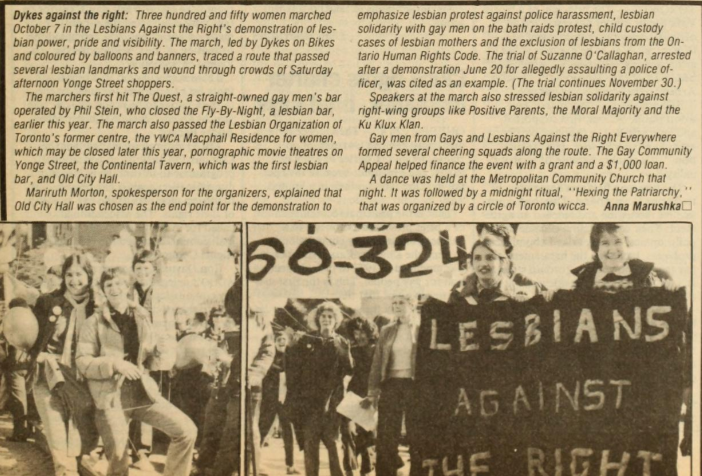
The First Dyke March
In 1993, the Lesbian Avengers organized the first Dyke March in Washington, DC, which was attended by over 20,000 women. It was held a few hours before the 1993 National March on Washington for Lesbian and Gay Rights, which had been happening yearly, since 1979. After that success, the Lesbian Avengers took the Dyke March home to NYC, and it became a staple, associated with the larger Pride events in June. From there, it spread to be held the day before the dominant Pride March in many cities across the world.

Here again, we see the foundations of a common pattern; lesbian get involved in gay and lesbian activism, feel they're being sidelined, and go off to create their own groups. A major source of inspiration for the Lesbian Avengers were the Radicalesbians, who had started as members of the Gay Liberation Front (GLF). As the future members of the Radicalesbians felt they were being exploited by the men they were working with in the GLF, Rita Mae Brown felt she had to do something to make space for lesbians, separate from gay men.
... Brown had learned in Redstockings, was consciousness-raising; and now, she announced in the GLF, she'd be starting all-lesbian consciousness-raising groups, "Lesbian oppression and homosexual male oppression have less in common than you might think,"... (Faderman, 2015)
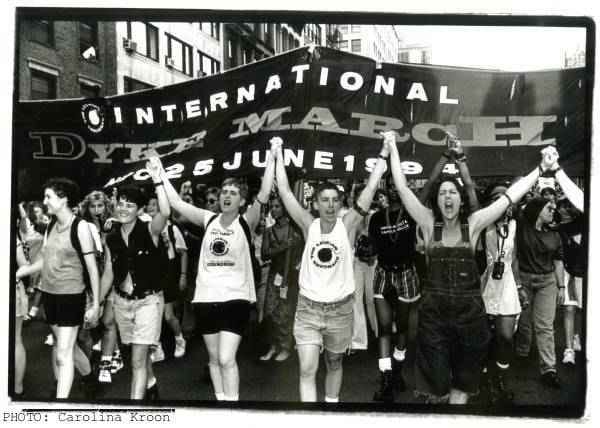
The Spirit Of The Dyke March
The Dyke March was created so lesbians could be lesbians, on their own terms, with their own unique politics. Lesbians had learned the hard way, over and over again, that the women's liberation movement often did not care for, prioritize or respect them. Lesbians also had come to terms with the fact that gay men treated them no better. So if lesbians, and in particular lesbian feminists, could not comfortably fit into either movement, they realized they needed to create their own.
“I think it’s important to remember that lesbians used to get lost in the gay-rights movement then, and I think they can still get lost in the LGTBQ+ movement today.” (Faderman, 2021)
One of the most notable characteristics of the early Dyke Marches, was that they were women-only. This is unsurprising, given that they were organized by lesbian feminists. While originally, marshals physically prevented men from entering the march, pushing them back onto the sidewalks, today, that is no longer the case.
In many ways, the Dyke March itself was just the public manifestation of what had already been happening for decades, but invisible to most. Lesbians had already defined themselves, not in relation to other women, not in relation to gay men, but simply as lesbians. Now, they were walking down the street, taking pride in their lesbian identities and lives for everyone to see.
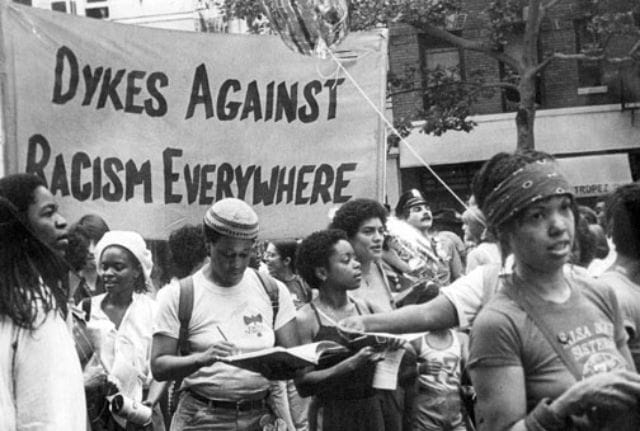
Questions To Consider
- Have you ever attended a Dyke March? What was that experience like?
- What makes it worthwhile or fulfilling to go to a Dyke March?
- Under what circumstances would you no longer attend the Dyke March?
- In your opinion, in what ways has the Dyke March strayed from its origins?
- If you could change one thing about your local Dyke March, what would it be?
References
Biren, J. E. (1993). A simple matter of justice: The 1993 March on Washington for lesbian, gay and bi equal rights and liberation [Film]. Frameline.
https://www.frameline.org/distribution/films/a-simple-matter-of-justice-the-1993-march-on-washington-for-lesbian-gay-and-bi-equal-rights-and-liberation
Brownworth, V. (2023, October 19). Radicalesbians, the first lesbian rights group post-Stonewall. Philadelphia Gay News.
https://epgn.com/2023/10/18/radicalesbians-the-first-lesbian-rights-group-post-stonewall/
Faderman, L. (2015). The gay revolution: The story of the struggle. Simon & Schuster.
https://www.goodreads.com/book/show/23492771-the-gay-revolution
George, C. (2021, June 25). An oral history of the Lesbian Avengers. The Cut.
https://www.thecut.com/2021/06/lesbian-avengers-and-the-dyke-march.html
Gottlieb, A. (2018, June 21). Queerly reading: Toronto’s unrecognized first Dyke March. Coach House Books.
https://chbooks.com/Blog/2018/Queerly-Reading-Toronto-s-Unrecognized-First-Dyke-March-by-Amy-Gottlieb
Kinsman, G. (2021, June 7). “Fuck you 52!”: Some notes towards a radical history of Toronto Pride 1981. Radical Noise.
Lesbian Avengers. (1994). Lesbian Avengers Dyke Manifesto [Zine]. Self-published.
https://archive.qzap.org/index.php/Detail/Object/Show/object_id/325
Lesbian Conference Committee. (1981). Final report: 1981 Lesbian Conference. Press Gang.
https://riseupfeministarchive.ca/wp-content/uploads/lesbianconference-1981-finalreport-organizingfor80s.pdf
Lesbians battle the right. (1981, October). The Body Politic.
https://archive.org/details/bodypolitic77toro/page/10/mode/2up
Marushka, A. (1981, November). Dykes against the right. The Body Politic.
https://archive.org/details/bodypolitic78toro/page/n13/mode/2up
Meaghan. (2014, November 12). Eating fire: A brief history of the Lesbian Avengers in NYC. Off The Grid.
https://www.villagepreservation.org/2014/11/12/eating-fire-a-brief-history-of-the-lesbian-avengers-in-nyc/
